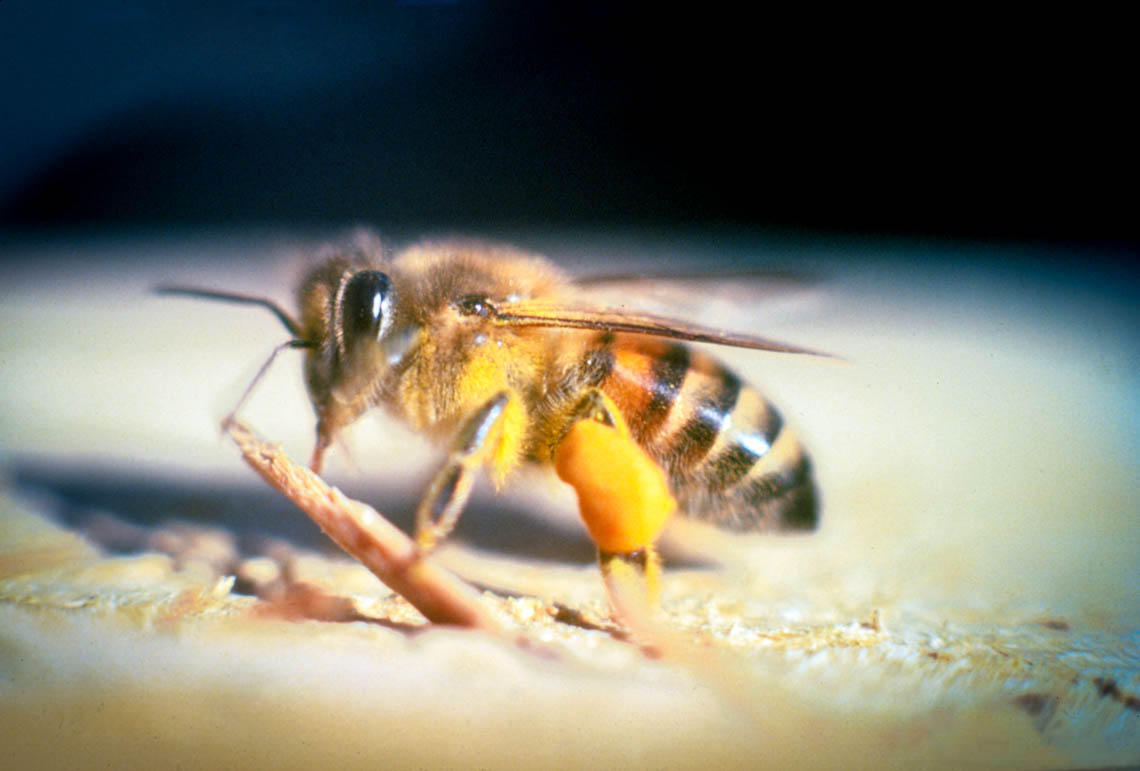
In 2011, alert harbor workers in Honolulu noticed bees inside a container of medical supplies shipped from Long Beach California. They closed the container and notified the Hawaiʻi Department of Agriculture (HDOA). The container was fumigated and HDOA sent the bees in for genetic testing: they were Africanized honeybees.
Honeybees are fairly widespread in Hawaiʻi, both in managed and feral hives. But we don’t have the Africanized honey bees that are present in much of the southern United States and Central America.
Africanized honeybees are nearly identical to their six-legged relatives kept for honey production: they look the same and they produce honey, but they are much more aggressive in defending their hives. Even something as insignificant as a barking dog can trigger bees to attack and ten times as many bees will descend. “It’s of particular concern when the person can’t get away from the attack,” says Noelani Waters, an entomologist with the Hawaiʻi Department of Agriculture’s apiary program. For the elderly, young children, or those with bee allergies, an attack can be fatal. “They have come already once,” says Waters “it’s very possible and extremely likely they will make it here again.”
With that in mind, HDOA has set up swarm traps around the harbors and airports. Monitoring around the airport is through the Māmalu Poepoe project, an interagency cooperative group that works to stop invasive species from reaching Hawaiʻi through airports. Every 6 weeks or so, crews walk around Kahului airport peering in gigantic, brown papery pots mounted about head height and baited with a pheromone to attract bees. These are swarm traps, designed to be the perfect landing place for swarming bees in search of a place to start a new hive. The goal is to intercept any Africanized bees before they become established.

African honeybees were first introduced to Brazil in 1957 with the goal of breeding honeybees better able to produce honey despite the heat and humidity. Unfortunately, they escaped quarantine before the less desirable traits–like their aggressive behavior–could be bred out of them.
The introduced drones hybridized with surrounding bees and continued to spread, taking over existing hives. Africanized honeybees spread north through Central America and into the Southern US. They first showed up in 1985 in California, traveling in contaminated cargo. By 1990, they had expanded from Mexico into Texas and are now spread from Florida to Southern California. Cooler temperatures likely limit their spread farther north, but the tropical climate of the Hawaiʻian Islands is hospitable to these bees.
Hawaiʻi has native bees – the solitary yellow-faced bees—but honeybees are introduced. Beekeepers brought these insects to the state in 1857. Initially, they were introduced to increase kiawe pollination, used at the time as a high-protein cattle feed. Today, honeybees in Hawaiʻi are some of the world’s highest honey producers. The lack of Africanized bees and overall health of Hawaiʻi-raised honeybees has led to a $10 million per year queen bee export industry. According to Waters, hives queened with Hawaiʻi-raised bees are key to the pollination of almond crops in California every spring. Hawaiʻi supplies 25% of the queen bees for the mainland U.S. and 75% of the queen bees imported to Canada. Hawaiʻi’s agricultural industry would suffer if Africanized honeybees reached our islands. These aggressive hybrids also threaten human health and safety. You can help. Report particularly aggressive hives, feral or managed, to Waters and her colleagues at the Hawaiʻi Department of Agriculture’s Apiary program at (808) 974-4138. Learn more about the program online at https://hdoa.hawaii.gov/pi/ppc/apiary-program-hawaii-beekeepers-registry/
Lissa Strohecker is the public relations and education specialist for the Maui Invasive Species Committee. She holds a biological sciences degree from Montana State University. Kia’i Moku, “Guarding the Island,” is prepared by the Maui Invasive Species Committee to provide information on protecting the island from invasive plants and animals that can threaten the island’s environment, economy, and quality of life.
This article was originally published in the Maui News on December 10th, 2017, as part of the Kia‘i Moku Column from the Maui Invasive Species Committee.
Read more Kiaʻi Moku articles.
